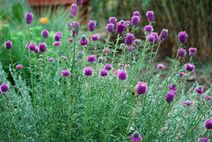Dalea purpurea
| Dalea purpurea | |
 | |
| Light: | |
| Moisture: | |
| Soil pH: | 5.6-8.4 |
| Height: | 3' |
| Blooms: | Mid Summer |
| Native to: | |
| Nitrogen Fixer Nectary | |
| Edible Rating: | |
| Medicinal Rating: | |
| Tea: | Yes |
Dalea purpurea (common name: purple prairie clover)
Easily distinguish between purple and white prairie clover before flowering by examining the leaves: narrow on purple, wide on white.
Propagation: Seed - pre-soak for 12 hours in warm water and sow in early spring in a greenhouse. When they are large enough to handle, prick the seedlings out into individual pots and plant them out into their permanent positions in the summer[1].
Cultivation: Requires a well-drained soil in full sun[1]. A deep-rooted plant, it prefers a sandy loam with added leaf mould[2]. This species is well-suited to informal and naturalistic plantings, especially as part of a collection of native species[1].
Plants are monocarpic, living for a number of years without flowering and then dying after flowering[1].
The stems, leaves and flowers are dotted with glands, making the plant look blistered[1].
This species has a symbiotic relationship with certain soil bacteria, these bacteria form nodules on the roots and fix atmospheric nitrogen. Some of this nitrogen is utilized by the growing plant but some can also be used by other plants growing nearby[1].
Range: Western N. America.
Habitat: Dry desert and alluvial soils to 2000 metres[1]. Sandy prairies in Texas[3].
Edibility: The root was used for chewing[4]. A pleasant sweet flavour[5].
The dried leaves are a tea substitute[4][5].
Medicinal: A poultice of the steeped bruised leaves has been applied to fresh wounds[5].
A decoction of the leaves and blossoms has been used in the treatment of heart problems, diarrhoea[5].
An infusion of the roots has been used in the treatment of measles[5].
Usage: The tough, elastic stems have been made into brooms[5].
Soil: Can grow in light and medium soils.
Drainage: Prefers well drained soil.
Flower Type: Hermaphrodite
Also Known As: Petalostemon violaceum. Michx.
Links
References
- ↑ 1.0 1.1 1.2 1.3 1.4 1.5 1.6 Huxley, Anthony. The New Royal Horticultural Society Dictionary of Gardening. MacMillan Press, 1992.
- ↑ Chittendon, Fred. RHS Dictionary of Plants. Oxford University Press, 1951.
- ↑ Diggs, George and Barney Lipscomb. Illustrated Flora of North Central Texas. Botanical Research Institute, 1999.
- ↑ 4.0 4.1 Facciola, Stephen. Cornucopia - A Source Book of Edible Plants. Kampong Publications, 1990.
- ↑ 5.0 5.1 5.2 5.3 5.4 5.5 Moerman, Daniel. Native American Ethnobotany. Timber Press, 1998.